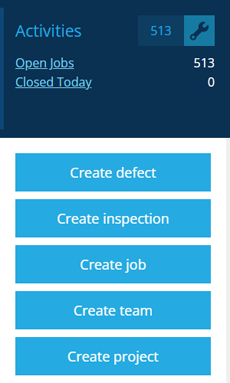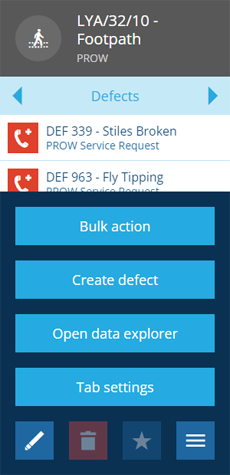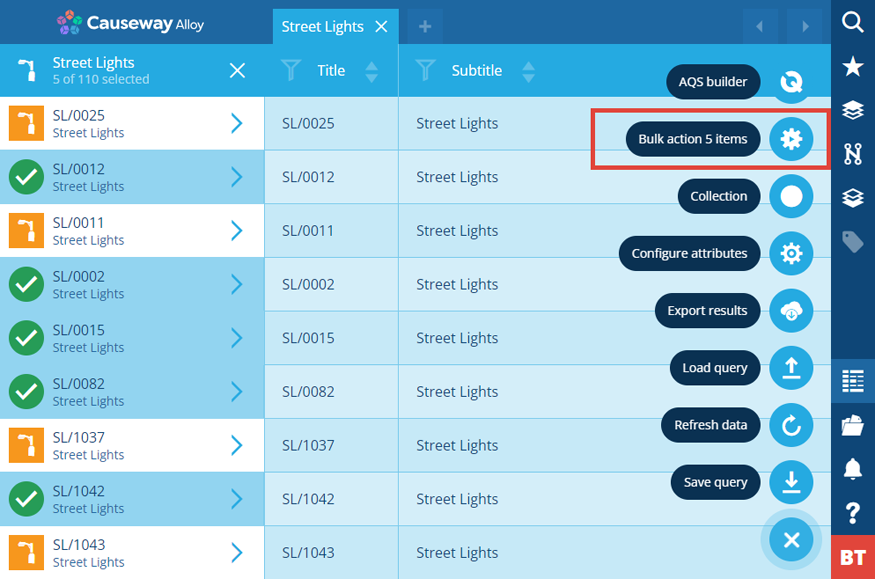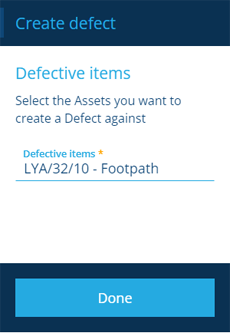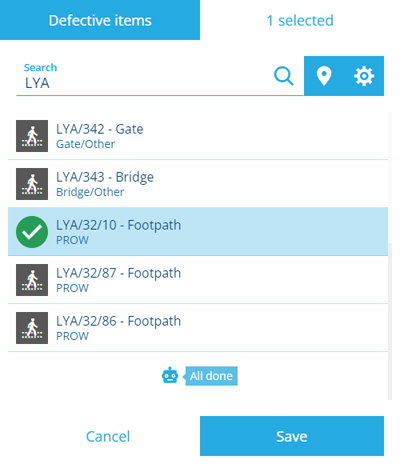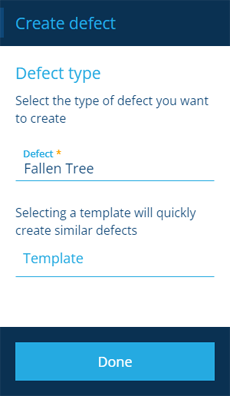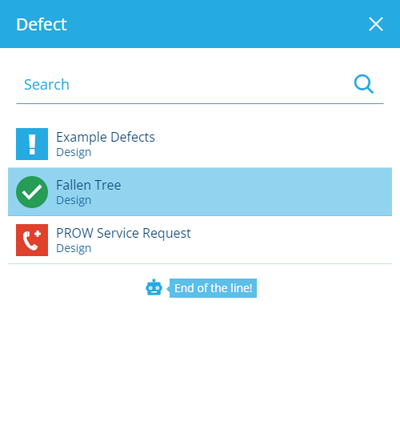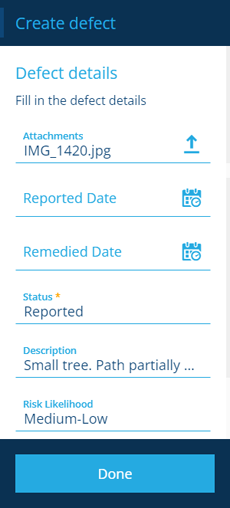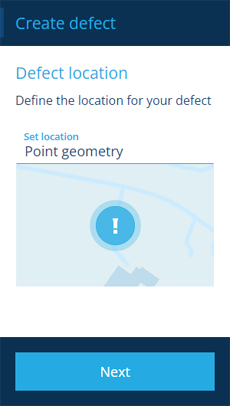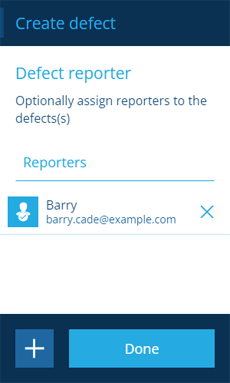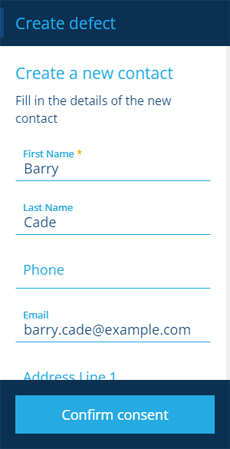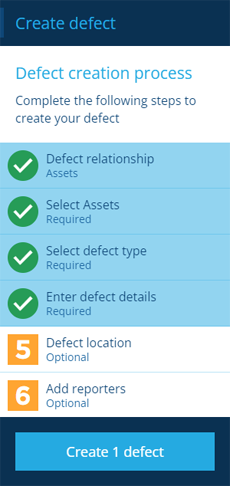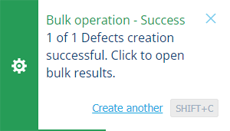Creating defects
Identify assets with defects
Create defects to keep track of issues that require attention.
You can create a defect against an asset to represent a reported fault or flaw. Defects can then be checked with inspections and remedied with jobs as needed.
Alloy Mobile users can also create new defects while in the field.
Before starting, ensure that a design exists which defines the type of defect you're about to create. Use the defect designs provided with installed modules or create your own.
Start the process
There are several ways to start creating a defect:
Start from the dashboard
Open the Activities dashboard card and select Create defect.
Start from an asset or activity item
To create a defect for the item you're viewing, switch to the Defects tab, select More in the action bar and choose Create defect. The creation process will start with steps 1 and 2 configured automatically.
Perform a bulk action
When using Search or the Data Explorer to find asset or activity items, you can perform a Create defect action on some or all of the resulting items. The creation process will start with steps 1 and 2 configured automatically.
To learn more, see Bulk actions.
The defect creation process
The key steps of this process will appear in the dashboard panel:
-
1 Defect relationship - required
-
2 Select parent item(s) - required, unless the relationship is None
-
3 Select defect type - required
-
4 Enter defect details - required
-
5 Defect location - optional
-
6 Add reporters - optional
You don't necessarily have to enter all of the defect's details upfront! Fields marked with an asterisk * are required. Other fields can be edited later.
1 Defect relationship
Choose the type of item you want to create a new defect for. This is usually set automatically, according to how you started the process. However, you can change it as needed:
-
Assets - record the condition of one or more assets.
-
Jobs - record a defect discovered during (or caused by) a job.
-
Inspections - record a defect discovered during an inspection.
-
Defects - record a defect caused by another defect.
-
None - record an isolated defect, e.g. a fly tipping incident.
2 Select parent item(s)
Select one or more Defective items of the type chosen in step 1. A new defect will be created for each one. To select items visually based on their location, select in the item picker's search box to switch to the map picker.
Select Done to choose the next step.
3 Select defect type
Choose the type of defect to create:
-
Defect * - choose from a list of defect designs that apply to the item(s) selected in step 2.
-
Template - pre-populate the new defect(s) with values from an existing template item.
Select Done to choose the next step.
4 Enter defect details
Enter values for the attributes of the defect design chosen in step 3. Any required attributes * must contain a value to continue. Some attributes may be populated with a default value, such as:
-
Status * - is set to Reported by default but can be changed.
-
Reported Date - if left blank, it will be set to the current date and time.
-
Defect Number - an automatically generated unique number (not shown in this step).
Select Done to choose the next step.
5 Defect location
Depending on the defect design chosen in step 3, this step may show as:
-
Optional - if left blank, the new defect(s) will inherit the geometry of the parent item(s) selected in step 2 (providing the parent's geometry type is allowed on the defect design). Alternatively, you can set a new geometry value! This is handy for situations where the shape/location of a defect should be represented differently, e.g. to record a pothole on a carriageway.
-
Required - you must set the new defect's geometry. It won't be inherited from the parent item(s). This happens if the Requires geometry property is enabled on the defect design.
-
No Geometry - the defect can't store any geometry. This happens if the Allowed geometry property is active but empty on the defect design.
-
Set from template - the new defect's geometry will match the template item chosen in step 3.
To explicitly set the geometry of the new defect(s), select this step and then Set location. Use the Geometry Editor to define the geometry and then select Save. By default, you can draw any geometry type, though this may be limited by the defect design.
Select Next to choose the next step.
To specify which geometry types are allowed on a design, see Editing general design details.
6 Add reporters
This is an optional step. To record who reported the defect (e.g. a member of the public), select Reporters, and then select one or more items of the Contacts design.
To create a new contact, select at the bottom. Fill in the fields as needed and then select Confirm consent.
Select Done to continue.
Always get consent from new reporter(s) before storing their contact details!
Finish the process
After completing the relevant steps, select Create to finish.
A notification will indicate whether the item was created successfully or an error occurred.
Create more defects
To quickly create more defects, select Create another in the notification before it disappears. The defect creation process will restart with the previous values intact, which you can then change as appropriate for subsequent new defects.
For more complex scenarios, you can build workflows that perform Create Item actions according to various conditions, which can be triggered automatically or on demand.
